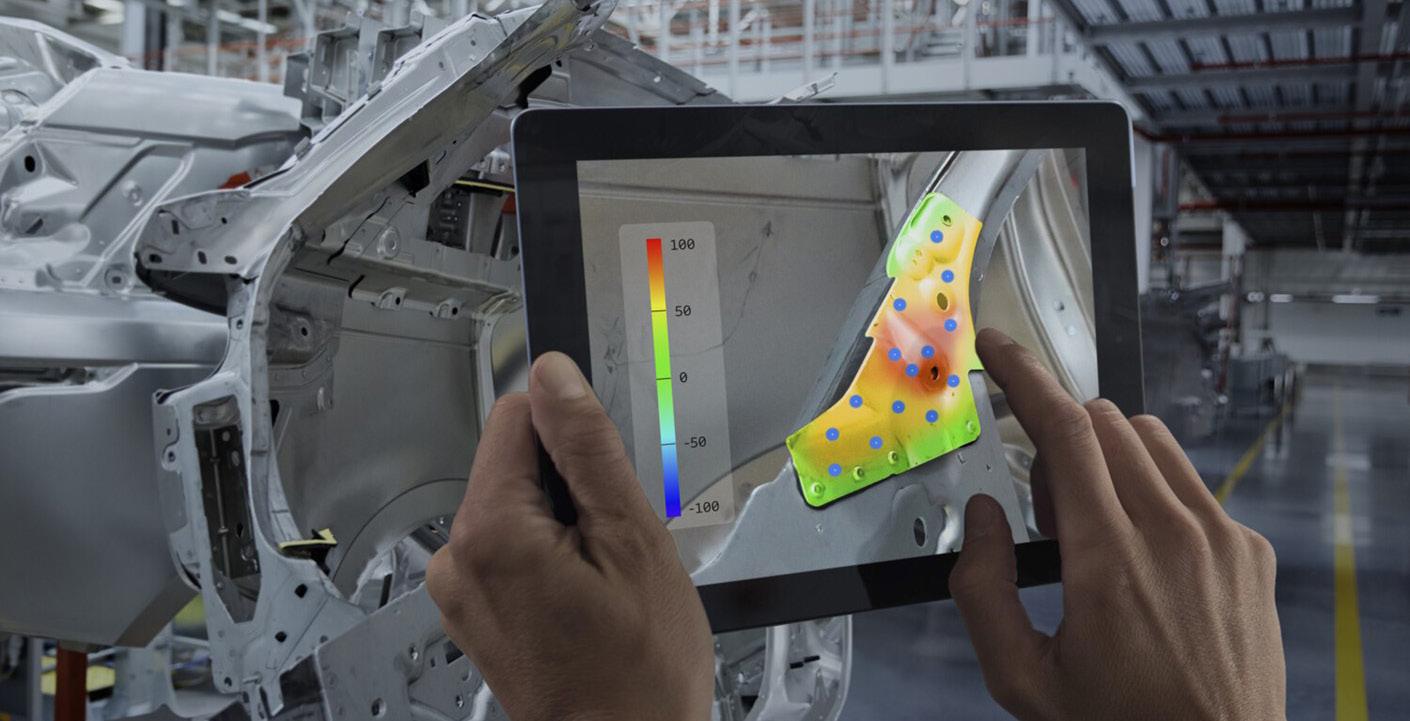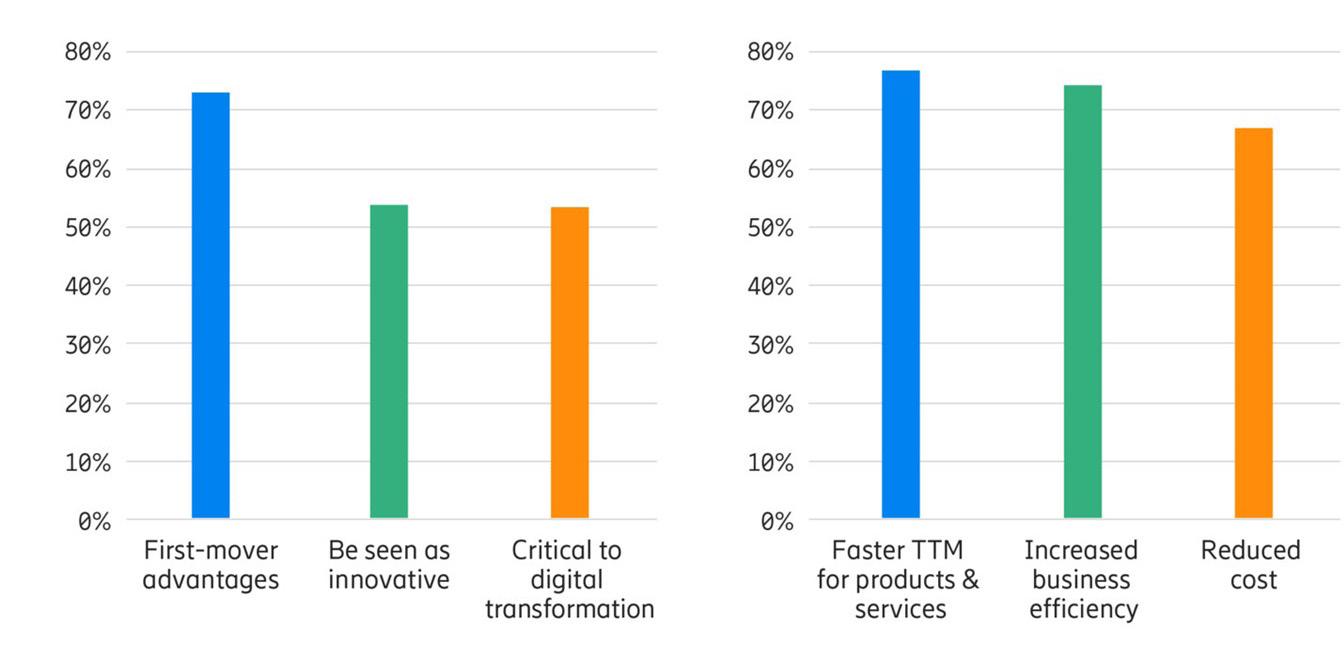
6 minute read
5G pushes importance of first-mover advantages to new levels
Chapter 2: First-mover advantages
5G pushes importance of first-mover advantages to new levels
Advertisement
The first blog in the Practitioner’s Guide series addressed how 5G contributes to accelerating the pace for businesses. This follow-up explains the importance of first-mover advantages for service providers and their enterprise customers.
In the 4G era, there was a choice between being a first mover and being a follower. For 5G, the bias has shifted to a market where first-mover advantages rule. Businesses see first-mover advantages as the most important strategic priority for 5G, with narrow windows to target for leadership.
Recap on the 4G launch When looking back at when 4G networks were launched, a few things were characteristic: • Communications service providers were choosing between first-mover and follower strategies, with significant variations between regions and within a given market. • 4G focused on the consumer value proposition. • Few communications service providers launched in the first year of service. • The initial performance difference between HSPA (maximum 168Mbps) and LTE (maximum 150Mbps) was small. Often with arguments that 3G was good enough. • There were few smartphone options available in the first 30 months.
The market dynamics for 5G are different. The global build of networks in the first years is close to parallel across the globe. The availability of devices, and adoption by consumers, in the first years, was on a different level. There are reasons to believe that firstmover advantages will rule in the 5G era. Further, the measurement of the advantages has moved from quarters to months.
Enterprises’ 5G priorities Ericsson conducted a major survey in 2018 to understand enterprises’ 5G priorities.
The study addressed both strategic and business priorities with a few factors standing out: • 73 percent of enterprises saw first-mover advantages as the most important strategic objective for 5G. • Two additional strategic objectives reached over 50 percent: the desire to be perceived as innovative (54 percent), and the understanding that 5G is key to digital transformation (53 percent). • Faster time-to-market for new products and services (77 percent) was the most crucial business objective. • And was closely followed by increased business efficiency (74 percent) and reduced cost (67 percent) in the business priority category.
So, what could one conclude from these figures? Faster TTM and first-mover advantage were a priority from the early 5G deployments. This is consistent with the priorities today.

Figure 1: Enterprises’ strategic (left) and business (right) priorities when it comes to 5G (Source: Ericsson, 2018)
Fifty-nine 5G networks launched in the first year First, the number of networks launched in the first year increased significantly. In 2019 we did see fifty-nine 5G network launches, to be compared with the four networks launches in the first year for 4G (2010).
This 15X difference is remarkable and is the result of a few factors: • 4G standardization followed the original 3GPP time-plan. • Service providers were hesitant about the pace of transition from 3G to 4G, as the 3G performance was comparable and perceived good enough. • Few 4G terminals were available at launch.
Communication service providers now pursue first-mover advantage strategies, best exemplified with the string of first announcements leading up to commercial service launches. In some markets, all three carriers launched on the same day, and six months between first and last 5G launch is a large gap. These narrow gaps are a clear indicator first-mover advantage strategies rule for 5G networks. This reality is relevant for businesses to consider as the 5G market moves faster than what they experienced in the early days of 4G.
5G has a vibrant device ecosystem. The 5G ecosystem differs towards the launch year for 4G on key points: • During the first 15 months, we did see launches of 95 5G devices with 180+ additional announcements (Source: GSA,
April 2020). • Smartphone announcements are the most important, but also include pocket routers, laptops and fixed wireless terminals for indoor and outdoor use. • Pivotal devices for market acceleration come to market 12 months earlier.
The diversity on the device side and the broad availability across various device types are strong proof points about the vast potential. The slope of the growth curve is similar, but the closing of the gap between initial network launches and the availability of terminals move in the curve closer in time. The impact on businesses is faster and earlier adoption of 5G, which can be applied in customer offerings and for rationalization of own processes.
Rapid 5G subscriber adoption in the first year 17.7 million subscribers adopted 5G services worldwide in the first year. For previous mobile generations, reaching the same volumes took 10 quarters for 4G, 11 quarters for 3G, and 14 quarters for 2G. This accelerated adoption rate by consumers is significant, we leap from a stable 14, 11 and 10 quarter cycle down to 4.
First, 5G is well understood by early adopters among consumers. Consumers were ready to buy the first 5G phones available, and the 5G subscriptions were introduced with a slight premium when compared to 4G.
Second, the fact 5G has a broader geographical spread from the star is an enabler for a continued fast ramp in years two and three of the 5G adoptions.
The first 5G use cases for businesses can leverage a strong adoption in the smartphone segment. We can also expect an increased emphasis on workforce mobility compared to what we did not see three months ago, beyond home and offices.
Front runners captured all 4G growth Ericsson noticed a small group of 4G service providers standing out for their remarkable performance. This front-runner group captured all mobile service provider growth in the previous decade. The CAGR for the forty-nine 4G front-runners worldwide was 8.5 percent up until 2018, at the same time as the remaining 238 services providers declined by 1.95 percent. Winners took it all for 4G.
Figure 2: Lead time for the first 17.7 million subscribers for different mobile network generations (Source: 5G Americas, 2020)

Front-runners entered the market early to stake out prime positions in an immature ecosystem. Early entrants did see market share gains among early adopters and premium price advantages as essential benefits. First-mover strategies have been successful among service providers and shaped the strategic preferences for 5G.
These learnings from service providers and 4G are in play as you approach businesses for 5G. The first-mover advantages and expectations for TTM gains are high. The positions in the initial ecosystem are limited. The territory gained in 2020, and 2021 is a crucial asset for growth from 2022 and onwards as the 5G market moves from the nail to the scale phase. Unlocking first-mover advantages Expect to see keen interest from your business customers to pursue a first-mover strategy. Beyond leveraging the strong momentum, we see for the consumer segment, businesses benefit from going through their 5G learning curve early. Leaders will focus on nailing use cases first in close collaboration with key stakeholders in the ecosystem.
Not being active in the forming year/s of 5G for your industry creates a learning deficit that will be hard to recover. The cost of acquiring the learning now is lower than the challenge to wait and hope you can enter later.
Early stages include one or several of the following steps: • time-limited trials for specific use cases • early 5G trials at business premises, for both private and managed local networks, for the initial target use cases • campus-wide networks with own staff as early adopters as the final step before network-wide realizations
Plan for extensive collaborations and cocreation initiatives to unlock the full values. Expect 5G to be more learning-intensive than 4G, where few over-the-top business applications required interactions with the network platform.









